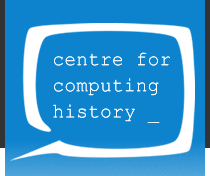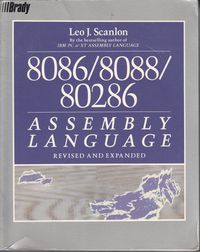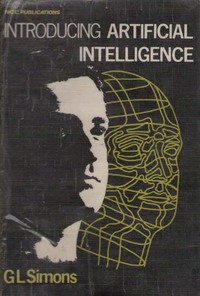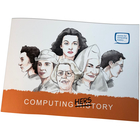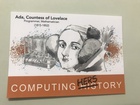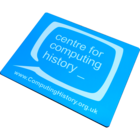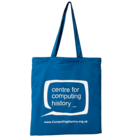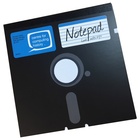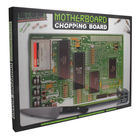Intel Books
The following is a list of Intel Books in the Centre for Computing History collection. It is not an exhaustive list of and other books may have been published. If you have a book that you would like to donate to our collection, please view our donations page.There are 13 Intel Books in our collection :
| Order By : Title - Release Date - Publisher |
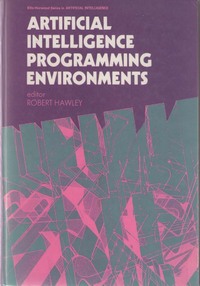 Date: 18th November 1987
Artificial Intelligence Programming Environments
Date: 18th November 1987
Artificial Intelligence Programming Environments
Publisher: Ellis Horwood Limited
Author: Robert Hawley
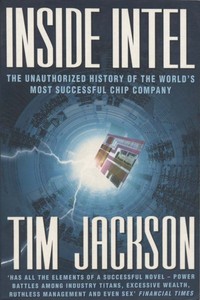 Date: 1998
Inside Intel
Date: 1998
Inside Intel
If you're sick of the upbeat tone of many computer industry sagas, you'll definitely enjoy Inside Intel, Tim Jackson's investigation into the secrets of Intel's success. Instead of the usual cast of blue-eyed whiz-kid billionaires, you'll find a darker story of brilliant technical coups tempered by serious blunders and savage competition. Naturally, technical innovation lies at the heart of the story, but Intel didn't always get it right--and sometimes teetered close to ruin. Success didn't come because the company never made mistakes, but because it could fight back savagely when it did. That the fight wasn't always clean, nor the personalities involved particularly pleasant, makes for a fascinating story.
Publisher: Harper Collins Publishers
Author: Tim Jackson
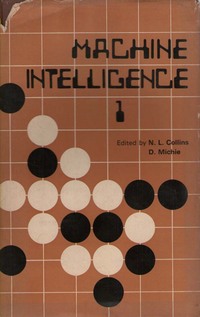 Date: 1967
Machine Intelligence Volume 1
Date: 1967
Machine Intelligence Volume 1
Contents
PREFACE by Sir Edward Collingwood FRS
INTRODUCTION
ABSTRACT FOUNDATIONS
1. Linear graphs and trees: H.I. SCOINS
2. Mathematical proofs about computer programs: D.C. COOPER
THEOREM PROVING
3. Beth-tree methods in automatic theorem-proving: R.J. POPPLESTONE
4. The resolution principle in theorem-proving: D. LUCKHAM
MACHINE LEARNING AND HEURISTIC PROGRAMMING
5. Tree-searching methods with an application to a network design problem: R.M. BURSTALL
6. Experiments with a learning component in a Go-Moku playing program: E.W. ELCOCK and A.M. MURRAY
7. An approach to automatic problem-solving: J. DORAN
8. Complete solution of the `Eight-Puzzle': P.D.A. SCHOFIELD
9. Strategy-building with the Graph Traverser: D. MICHIE
COGNITIVE PROCESSES: METHODS AND MODELS
10. Networks as models of word storage: G.R. KISS
11. Will seeing machines have illusions? R.L. GREGORY
PATTERN RECOGNITION
12. Perception, picture processing and computers: Dr M.B. CLOWES
13. Automatic speech recognition: a problem for machine intelligence: D.R. HILL
PROBLEM-ORIENTED LANGUAGES
14. Simply partitioned data structures: the compiler-compiler re-examined: R.A. BROOKER and J.S. ROHL
15. The third-order compiler: a context for free man-machine communication: R.B.E. NAPPER
16. Principles for implementing useful subsets of advanced programming languages: G.F. COULOURIS
17. Interrogation languages: J.M. FOSTER
SUBJECT INDEX
AUTHOR INDEX
Bibliographic details
Machine Intelligence 1
Editors: N.L. Collins and Donald Michie
Experimental Programming Unit, University of Edinburgh
Publisher: Oliver and Boyd 1967
Proceedings of the First International Machine Intelligence Workshop, held at Edinburgh, September 1965. Host laboratory: experimental Programming Unit, University of Edinburgh, UK.
Publisher: Oliver & Boyd
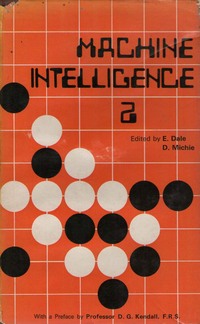 Date: 1968
Machine Intelligence Volume 2
Date: 1968
Machine Intelligence Volume 2
Contents
PREFACE by David Kendall
INTRODUCTION
ABSTRACT FOUNDATIONS
1. Semantics of assignment: R.M. BURSTALL
2. Some transformations and standard forms of graphs, with applications to computer programs: D.C. COOPER
3. Data representation-the key to conceptualisation: D.B. VIGOR
MECHANISED MATHEMATICS
4. An approach to analytic integration using ordered algebraic expressions: L.I. HODGSON
5. Some theorem-proving strategies based on the resolution principle: J.L. DARLINGTON
MACHINE LEARNING AND HEURISTIC PROGRAMMING
6. Automatic description and recognition of board patterns in Go-Moku: A.M. MURRAY and E.W. ELCOCK
7. A five-year plan for automatic chess: I.J. GOOD
8. New developments of the Graph Traverser: J. DORAN
9. BOXES: an experiment in adaptive control: D. MICHIE and R.A. CHAMBERS
10. A regression analysis program incorporating heuristic term selection: J.S. COLLINS
COGNITIVE PROCESSES: METHODS AND MODELS
11. A limited dictionary for syntactic analysis: P. BRATLEY and D.J. DAKIN
PROBLEM-ORIENTED LANGUAGES
12. POP-1: an on-line language: R.J. POPPLESTONE
13. Self-improvement in query languages: J.M. FOSTER
14. POP-2 reference manual: R.M. BURSTALL and R.J. POPPLESTONE
INDEX
Bibliographic details
Machine Intelligence 2
Editors:
* Ella Dale and Donald Michie
Department of Machine Intelligence and Perception, University of Edinburgh
Publisher: Oliver and Boyd 1968
Proceedings of the Second Annual Machine Intelligence Workshop, University of Edinburgh, September 1966.
Publisher: Oliver & Boyd
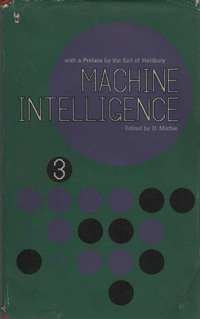 Date: 1968
Machine Intelligence Volume 3
Date: 1968
Machine Intelligence Volume 3
Contents
PREFACE by the Earl of Halsbury
INTRODUCTION
MATHEMATICAL FOUNDATIONS
1. The morphology of prex-an essay in meta-algorithmics. J. LASKI
2. Program Schemata. M.S. PATERSON
3. Language definition and compiler validation. J.J. FLORENTIN
4. Placing trees in lexicographic order. H.I. SCOINS
THEOREM PROVING
5. A new look at mathematics and its mechanization. B. MELTZER
6. Some notes on resolution strategies. B. MELTZER
7. The generalized resolution principle. J.A. ROBINSON
8. Some tree-paring strategies for theorem proving. D. LUCKHAM
9. Automatic theorem proving with equality substitutions and mathematical induction. J.L. DARLINGTON
MACHINE LEARNING AND HEURISTIC PROGRAMMING
10. On representations of problems of reasoning about actions. S. AMAREL
11. Descriptions. E.W. ELCOCK
12. Kalah on Atlas. A.G. BELL
13. Experiments with a pleasure-seeking automaton. J.E. DORAN
14. Collective behaviour and control problems. V.I. VARSHAVSKY
MAN-MACHINE INTERACTION
15. A comparison of heuristic, interactive, and unaided methods of solving a shortest-route problem. D. MICHIE, J.G. FLEMING and
J.V. OLDFIELD
16. Interactive programming at Carneige Tech. A.H. BOND
17. Maintenance of large computer systems - the engineer's assistant. M.H.J. BAYLIS
COGNITIVE PROCESSES: METHODS AND MODELS
18. The syntactic analysis of English by machine. J.P. THORNE, P. BRATLEY and H. DEWAR
19. The adaptive memorization of sequences. H.C. LONGUET-HIGGINS and A. ORTONY
PATTERN RECOGNITION
20. An application of Graph Theory in pattern recognition. C.J. HILDITCH
PROBLEM-ORIENTED LANGUAGES
21. Some semantics for data structures. D. PARK
22. Writing search algorithms in functional form. R.M. BURSTALL
23. Assertions: programs written without specifying unneccessary order. J.M. FOSTER
24. The design philosophy of POP-2. R.J. POPPLESTONE
INDEX
Bibliographic details
Machine Intelligence 3
Editor:
Donald Michie
Department of Machine Intelligence and Perception, University of Edinburgh
Publisher: Edinburgh University Press, 1968
Proceedings of the Third Annual Machine Intelligence Workshop, University of Edinburgh, September 1967.
Publisher: Edinburgh University Press
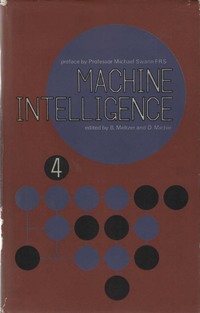 Date: 1969
Machine Intelligence Volume 4
Date: 1969
Machine Intelligence Volume 4
PREFACE by Michael Swann, FRS v MATHEMATICAL FOUNDATIONS 1. Program scheme equivalences and second-order logic. D.C. COOPER 3 2. Programs and their proofs: an algebraic approach. R.M. BURSTALL and P.J. LANDIN 17 3. Towards the unique decomposition of graphs. C.R. SNOW and H.I. SCOINS 45 THEOREM PROVING 4. Advances and problems in mechanical proof procedures. D. PRAWITZ 59 5. Theorem-provers combining model elimination and resolution. D.W. LOVELAND 6. Semantic trees in automatic theorem-proving. R. KOWALSKI and P.J. HAYES 87 7. A machine-oriented logic incorporating the equality relation. E.E. SIBERT 103 8. Paramodulation and theorem-proving in first-order theories with equality. G. ROBINSON and L. WOS 135 9. Mechanizing higher-order logic. J.A. ROBINSON 151 DEDUCTIVE INFORMATION RETRIEVAL 10. Theorem proving and information retrieval. J.L. DARLINGTON 173 11. Theorem proving by resolution as a basis for question-answering systems. C. CORDELL GREEN 183 MACHINE LEARNING AND HEURISTIC PROGRAMMING 12. Heuristic Dendral: a program for generating explanatory hypotheses in organic chemistry. B. BUCHANAN, G. SUTHERLAND and E.A. FEIGENBAUM 209 13. A chess-playing program. J.J. SCOTT 255 14. Analysis of the machine chess game. I.J. GOOD 267 15. PROSE - Parsing Recogniser Outputting Sentences in English. D.B. VIGOR, D. URQUHART and A. WILKINSON 271 16. The organization of interaction in collectives of automata. V.I. VARSHAVSKY 285 COGNITIVE PROCESSES: METHODS AND MODELS 17. Steps towards a model of word selection. G.R. KISS 315 18. The game of hare and hounds and the statistical study of literary vocabulary. S.H. STOREY and M.A. MAYBREY 337 19. The holophone - recent developments. D.J. WILLSHAW and H.C. LONGUET-HIGGINS 349 PATTERN RECOGNITION 20. Pictorial relationships - a syntactic approach. M.B. CLOWES 361 21. On the construction of an efficient feature space for optical character recognition. A.W.M. COOMBS 385 22. Linear skeletons from square cupboards. C.J. HILDITCH 403 PROBLEM-ORIENTED LANGUAGES 23. Absys 1: an incremental compiler for assertions; an introduction. J.M. FOSTER and E.W. ELCOCK 423 PRINCIPLES FOR DESIGNING INTELLIGENT ROBOTS 24. Planning and generalisation in an automaton/environment system. J.E. DORAN 433 25. Freddy in toyland. R.J. POPPLESTONE 455 26. Some philosophical problems from the standpoint of artificial intelligence. J. McCARTHY and P.J. HAYES 463 INDEX 505
Publisher: Edinburgh University Press
 Date: 1969
Machine Intelligence Volume 5
Date: 1969
Machine Intelligence Volume 5
Proceedings of the Fifth Annual Machine Intelligence Workshop, Edinburgh, 1969
Contents
INTRODUCTION vii
PROLOGUE
Intelligent machinery. A.M. TURING [1912-1954] 3
MATHEMATICAL FOUNDATIONS
1 Properties of programs and partial function logic.
Z. MANNA and J. McCarthy 27
2 Program schemes and recursive function theory. R. MILNER 39
3 Fixpoint induction and proofs of program properties. D. PARK 59
4 Formal description of program structure and semantics in first
order logic. R.M. BURSTALL 79
5 A program machine symmetric automata theory. P.J. LANDIN 99
MECHANIZED REASONING
6 A note on mechanizing higher order logic. J.A. ROBINSON 121
7 Transformational systems and the algebraic structure of atomic
formulas. J.C. REYNOLDS 135
8 A note on inductive generalization. C.D. PLOTKIN 153
9 Power amplification for automatic theorem-provers. B.MELTZER 165
10 Search strategies for theorem-proving. R.KOWALSKI 181
11 An experiment in automatic induction. R.J. POPPLESTONE 203
MACHINE LEARNING AND HEURISTIC SEARCH
12 First results on the effect of error in heuristic search.
I. POHL 219
13 A set-oriented property-structure representation
for binary relations, SBP. E.J.SANDEWALL 237
14 Rediscovering some problems of artificial intelligence in the
context of organic chemistry.
B.G. BUCHANAN, G.L. SUTHERLAND and E.A. FEIGENBAUM 253
15 Memo functions, the graph Traverser and a simple control
situation. D.L. MARSH 281
16 Experiments with the adaptive Graph Traverser.
D. MICHIE and R. ROSS 301
MAN-MACHINE INTERACTION
17 An interactive theorem-proving program.
J.R. ALLEN and D. LUCKHAM 321
18 A symbol manipulation system.
F.V. McBRIDE, D.J.T. MORRISON and R.M. PENGELLY 337
COGNITIVE PROCESSES: METHODS AND MODELS
19 Associative memory models.
D. WILLSHAW and H.C. LONGUET-HIGGINS 351
20 Hierarchical decomposition of complexity. M.H. VAN EMDEN 361
PATTERN RECOGNITION
21 A grammar for the topological analysis of plane figures.
P.BUNEMAN 383
22 Shape analysis by use of Walsh functions. N.H. SEARLE 395
23 Conic sections in automatic chromosome analysis. K.X. PATON 411
24 Centromere finding: some shape descriptions for small
chromosome outlines. D.RUTOVITZ 435
25 ESOTERIC II- an approach to practical voice control:
progress report. D.R. HILL and E.B. WACKER 463
26 On imitative systems theory and pattern recognition.
P.A.V. HALL 495
PRINCIPLES FOR DESIGNING INTELLIGENT ROBOTS
27 Planning and robots. J.E. DORAN 519
28 Robotologic. P.J. HAYES 533
29 Design of low-cost equipment for cognitive robot research.
H.G. BARROW and S.H. SALTER 555
APPENDIX
Bibliography on proving the correctness of computer programs.
R.L. LONDON 569
INDEX 581
Publisher: Edinburgh University Press
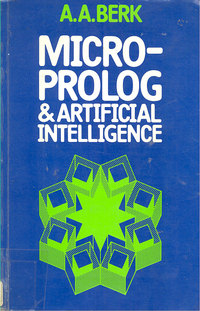 Date: 1985
Micro-Prolog & Artificial Intelligence
Date: 1985
Micro-Prolog & Artificial Intelligence
MicroPROLOG is a dialect of the list-processing language, PROLOG, which has been adapted specially for microcomputers. PROLOG, known as one of the best languages for experimenting with artificial intelligence, has a rather 'human' approach to problem-solving. It can hold a set of rules in a 'knowledge base', and answer general questions using them. This allows such subjects as logic and language to be analysed by defining the basic attributes and then querying those attributes, very much as we do with the knowledge base held in our own brains. Expert systems are a direct example of this type of reasoning, and this is explained in the book.
This book tackles the usually difficult task of explaining MicroPROLOG simply and concisely, and introduces the language in company with its main application - artificial intelligence. It is based heavily on examples, and has been prepared with reference to MicroPROLOG packages on the IBM (and look-alikes), Acorn, Sinclair and other machines.
Publisher: Collins
Author: Dr. A. A. Berk
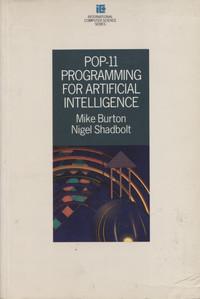 Date: 1987
POP-11 Programming for Artificial Intelligence
Date: 1987
POP-11 Programming for Artificial Intelligence
"In Part one, the authors provide an introduction to the POP-11 programming language. In Part Two, they show how POP-11 can be used to develop practical artificial intelligence programs."
Publisher: Addison-Wesley Publishing Company
Author: Mike Burton and Nigel Shadbolt
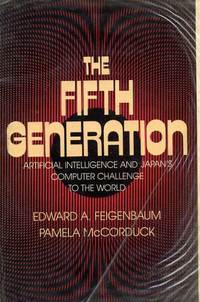 Date: 1984
The Fifth Generation
Date: 1984
The Fifth Generation
Artificial Intelligence and Japan's Computer Challenge to the World
Publisher: Michael Joseph Ltd.
Author: Edward A. Feigenbaum & Pamela McCorduck
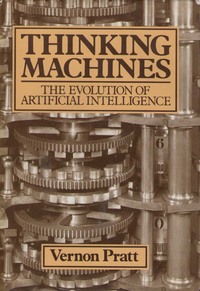 Date: October 1987
Thinking Machines: The Evolution of Artificial Intelligence
Date: October 1987
Thinking Machines: The Evolution of Artificial Intelligence
Artificial intelligence is becoming the most significant single development of our time - promising as it does the end of 'work' and consequent social revolution.
'Clever' machines are playing an increasingly important role in our lives, and with the 'Fifth Generation' project in Japan and parallel developments in America and Europe well under way, their impact is growing incalculably.
Publisher: Basil Blackwell
Author: Vernon Pratt
